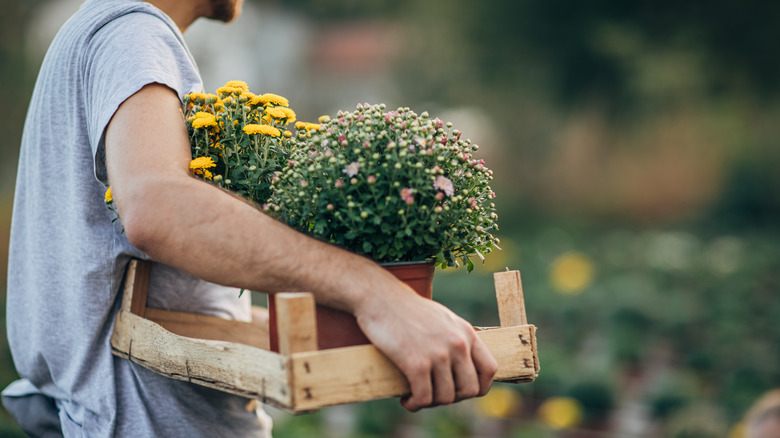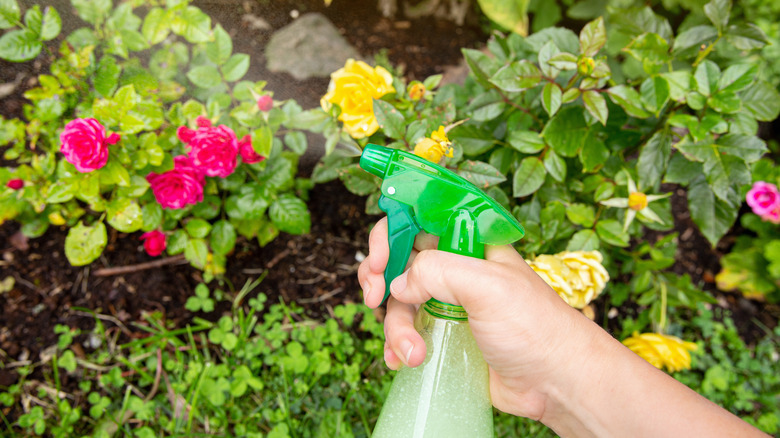The Important Step You'll Want To Take Before Bringing Your Plants Inside For The Winter
As winter approaches, you might be considering moving your outdoor plants inside. While the move is necessary to protect your plants from the harsh winter elements, it's crucial to consider the potential for pest infestations. The key is to be proactive rather than reactive. This is where the crucial process of debugging comes in. Debugging entails carefully inspecting and treating both the plants and their soil to eliminate as many pests as possible before they make their grand entrance indoors.
The reality is that once you bring your plants inside, they become susceptible to rapid and severe outbreaks of pests such as spider mites and aphids. These annoying critters can multiply exponentially in a short span, wreaking havoc on your cherished houseplants. Worse yet, these pest outbreaks are often stealthy; by the time you spot them, they may have already inflicted significant harm. The confined conditions of your home create a perfect storm for these pests, as there are fewer natural predators to keep them in check. That's why these outbreaks are common and more devastating when they occur indoors. Trust us, dealing with a full-blown infestation is far more cumbersome than preventing one in the first place.
The best time to bring plants inside
Knowing when to bring your plants inside for the winter is a balancing act. Do it too early, and you risk depriving them of the beneficial effects of natural sunlight and air circulation. Wait too long, and you expose them to the risks of frost and harsh weather conditions that weaken them before they ever enter your door. To mitigate these risks, move your plants indoors at least two weeks before the average date of the first frost in your location. To pinpoint this date, check historical weather data online or get in touch with your local nursery, where experts are usually happy to share their region-specific advice.
This two-week period serves as an adjustment buffer for your plants. During this time, observe them closely and look for any signs of stress, disease, or pest infestation. Then, tackle these issues in a controlled, outdoor environment rather than dealing with them after you've moved your plants inside. It's especially important as the low-light and low-humidity conditions, typical indoors during the winter, can exacerbate plant stress and make recovery more challenging. The two-week lead time allows you to carry out the all-important debugging process. This ensures that you aren't inadvertently introducing pests into your home environment, where they could multiply and spread to other houseplants. In essence, the timing isn't just about avoiding frost; it's about comprehensive preparation that ensures your plants are as healthy as possible before they transition to the indoors.
How to debug plants before bringing them inside
Debugging your plants is not a step to be skipped or rushed. Firstly, start by cleaning inside the pot. Remove any dead or fallen leaves and prune them where necessary. When pruning, pay special attention to the undersides of leaves, where pests like to hide. Once you've done a thorough cleaning, consider repotting. Using sterile potting soil is a must. If you're using previously used planters, scrub them well first. Ideally, you'll do this one to two days before placing the plants inside. This helps prevent the contamination of new soil.
The next step involves soaking the soil. You can fully soak smaller pots in warm water for 15 minutes. This will force pests to the surface, where they can be easily removed. After soaking the soil, spray the plant with an insecticidal soap. Ensure you follow the instructions on the label and focus on problem areas where pests are most likely to hide. Finally, consider mulching with cedar, as its natural oils can be an additional repellent for certain types of pests. Once you've completed all these steps, your plants should be ready to make their winter move indoors, substantially reducing the risk of a sudden pest outbreak once they're inside.


